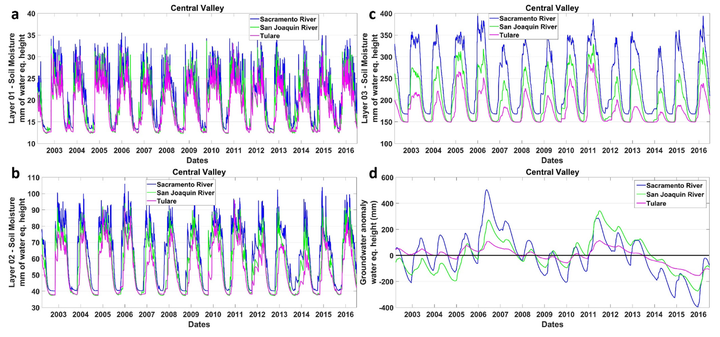Model-data fusion of hydrologic simulations and GRACE terrestrial water storage observations to estimate changes in water table depth
 Daily time series of the VIC-4L-simulated moisture content of the (a) top soil layer, (b) second from top soil layer, and (c) third from top soil layer for the entire simulation period. Daily time series of the VIC-4L-simulated groundwater anomalies expressed as deviations of the water equivalent height (d). All time series are spatially averaged over each of the three basins in Central Valley.
Daily time series of the VIC-4L-simulated moisture content of the (a) top soil layer, (b) second from top soil layer, and (c) third from top soil layer for the entire simulation period. Daily time series of the VIC-4L-simulated groundwater anomalies expressed as deviations of the water equivalent height (d). All time series are spatially averaged over each of the three basins in Central Valley.Abstract
Despite numerous advances in continental-scale hydrologic modeling and improvements in global Land Surface Models, an accurate representation of regional water table depth (WTD) remains a challenge. Data assimilation of observations from the Gravity Recovery and Climate Experiment (GRACE) mission leads to improvements in the accuracy of hydrologic models, ultimately resulting in more reliable estimates of lumped water storage. However, the usually shallow groundwater compartment of many models presents a problem with GRACE assimilation techniques, as these satellite observations also represent changes in deeper soils and aquifers. To improve the accuracy of modeled groundwater estimates and allow the representation of WTD at finer spatial scales, we implemented a simple, yet novel approach to integrate GRACE data, by augmenting the Variable Infiltration Capacity (VIC) hydrologic model. First, the subsurface model structural representation was modified by incorporating an additional (fourth) soil layer of varying depth (up to 1000 m) in VIC as the bottom ‘groundwater’ layer. This addition allows the model to reproduce water storage variability not only in shallow soils but also in deeper groundwater, in order to allow integration of the full GRACE-observed variability. Second, a Direct Insertion scheme was developed that integrates the high temporal (daily) and spatial (∼6.94 km) resolution model outputs to match the GRACE resolution, performs the integration, and then disaggregates the updated model state after the assimilation step. Simulations were performed with and without Direct Insertion over the three largest river basins in California and including the Central Valley, in order to test the augmented model’s ability to capture seasonal and inter-annual trends in the water table. This is the first-ever fusion of GRACE total water storage change observations with hydrologic simulations aiming at the determination of water table depth dynamics, at spatial scales potentially useful for local water management.